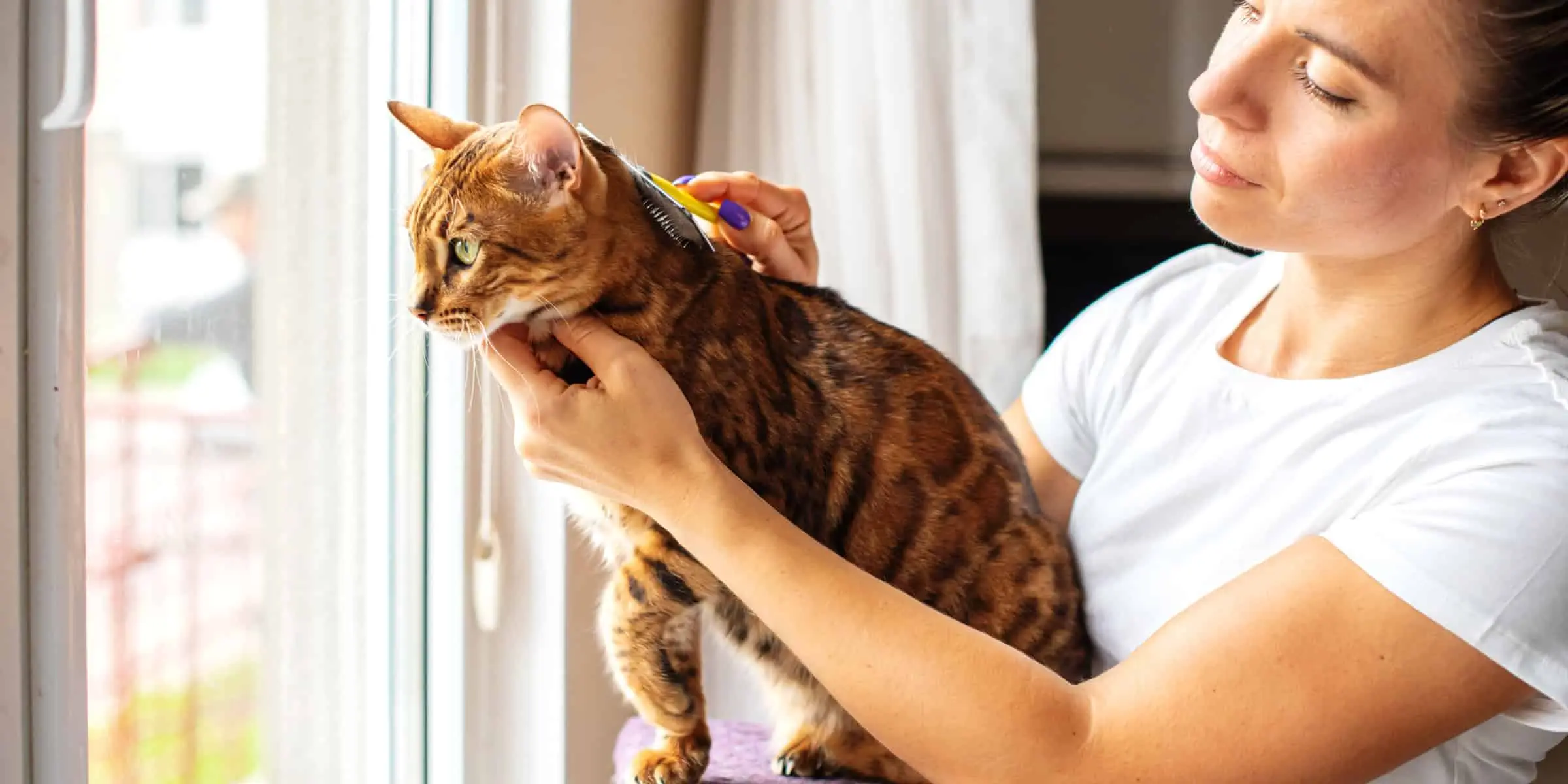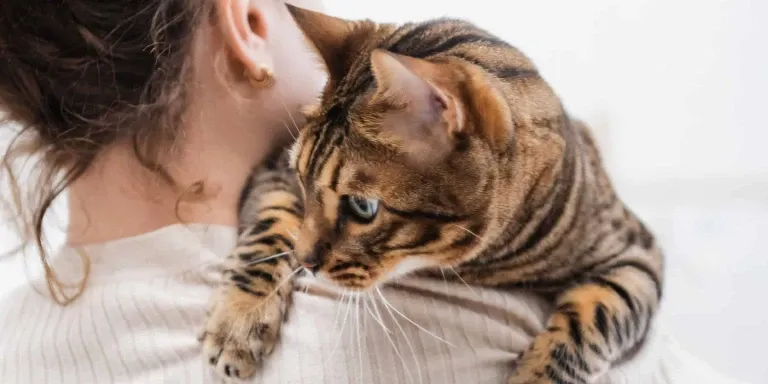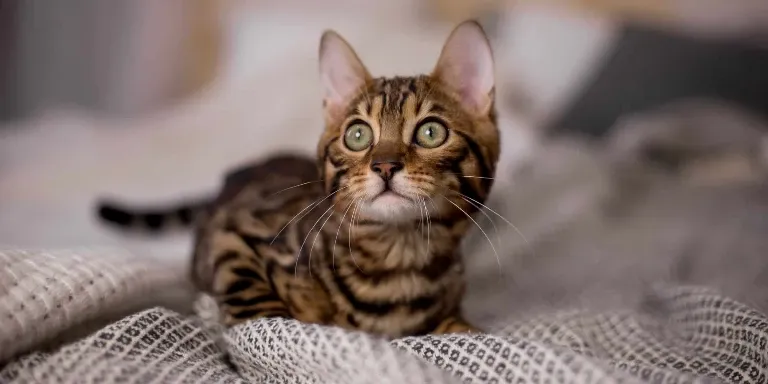The Best Fluffy Pancakes recipe you will fall in love with. Full of tips and tricks to help you make the best pancakes.

Are you considering adding a Bengal cat to your family? Before you make the decision, it’s important to understand the unique characteristics and needs of this breed.
Bengal cats can be more demanding in terms of attention and playtime than some other breeds, but they are generally not considered difficult to keep. They are intelligent, active, and social animals that thrive on interaction with their owners and can make great pets for those willing to provide them with proper care and stimulation.
Known for their striking appearance with their wild-looking spots and stripes resembling those of their wild African ancestor, the leopard cat, their beauty isn’t the only thing that sets them apart.
Bengal cats have high energy levels and strong hunting instincts, which can make them more challenging to care for than some other breeds. However, with the right knowledge and resources, you can provide a happy and healthy home for your Bengal cat.
In this article, we’ll explore the different aspects of caring for a Bengal cat, including their energy levels, grooming needs, health concerns, and more. By the end, you’ll have a better understanding of whether a Bengal cat is the right fit for your lifestyle and home.
Understanding the Bengal cat breed
You might be wondering what makes Bengal cats unique, but let me tell you, they’re a breed like no other! They have a distinctive and striking appearance with their wild-looking coat patterns and athletic build.
However, it’s not just their appearance that sets them apart, but their temperament as well. Bengal cats are known for their energetic, curious, and playful nature. They love to climb, run, and play for hours on end, which makes them perfect for families with an active lifestyle.
The origins of Bengal cats can be traced back to the 1960s, when a breeder in California crossed a domestic cat with an Asian leopard cat. The goal was to create a breed that had the wild and exotic appearance of a leopard but with the loving and affectionate temperament of a domestic cat.
These early Bengal cats were then bred with other domestic cats to create the breed we know today. Despite their wild appearance, Bengal cats are fully domesticated and make great pets, as long as you’re prepared to provide them with plenty of exercise and stimulation.
High energy levels
If you’re looking for an energetic companion, a Bengal cat might just be the perfect match for you. These feline species are known for their high energy levels and love for playtime. A Bengal cat can run up to 30 miles per hour, which is faster than most dog breeds!
However, with this high energy level comes the need for ample playtime requirements. Bengal cats need plenty of physical and mental stimulation to keep them occupied, and if they don’t get enough playtime, they can become bored and destructive. To manage their hyperactivity, it’s important to provide them with a variety of toys, activities, and climbing structures.
Additionally, incorporating playtime into their daily routine can help keep them stimulated and prevent destructive behavior. With proper management of their energy, a Bengal cat can become a loving and loyal companion.
Strong hunting instincts
When living with a Bengal cat, it can be quite the experience to witness their strong hunting instincts in action. These cats are known for their love of play and their need to hunt, which can sometimes be a challenge for owners who prefer indoor living for their pets.
While it’s possible to keep a Bengal cat solely indoors, it’s important to ensure that they have plenty of toys and activities to keep them occupied and prevent boredom. Training can also be a helpful tool for managing a Bengal cat’s instincts.
One technique is to provide them with puzzle toys that mimic hunting behaviors, which can help satisfy their need to hunt and keep them mentally stimulated. It’s also important to establish clear boundaries and provide training on appropriate play behavior, as Bengal cats can become overly aggressive during playtime.
With patience, consistency, and proper training, you can enjoy the company of a Bengal cat while also keeping them safe and happy in both indoor and outdoor environments.
Litter box training
Litter box training can be a breeze with the right techniques and tools, but have you ever wondered why some cats struggle with using the litter box consistently?
Bengal cats are known to be a little more challenging when it comes to litter box training. This is because they’re very particular about cleanliness and have a strong desire to bury their waste. Therefore, it’s important to use the right training methods to ensure that your Bengal cat is comfortable using the litter box.
One of the common mistakes that people make when training their Bengal cat is using the wrong type of litter. Bengal cats prefer a fine-grained, unscented litter that’s easy to dig and covers their waste well. Using a litter that’s too coarse or has a strong scent can discourage your cat from using the litter box.
It’s also important to keep the litter box clean and to have enough litter boxes for your cat. With patience and consistency, your Bengal cat can be successfully trained to use the litter box.
Grooming needs
To keep your Bengal cat looking and feeling their best, it’s important to regularly groom them.
Regular brushing is essential to remove dead hair and distribute natural oils throughout their coat, which helps to prevent matting and tangling. Bengal cats are known for their high energy levels and love of play, which can lead to excess shedding. To control shedding, consider using a slicker brush or a rubber grooming glove to remove loose hair.
A professional grooming session every few months can also help keep their coat in top condition. In addition to regular brushing and shedding control, it’s important to bathe your Bengal cat occasionally. However, use a cat-specific shampoo and avoid getting water in their ears or eyes. To make bathing easier, consider using a non-slip mat in the bathtub or sink.
After bathing, use a towel to dry your cat thoroughly and finish with a brush to prevent matting. By following these grooming tips, you can help your Bengal cat maintain a healthy and shiny coat.
Health concerns
Hey, you might want to consider taking care of your health concerns when it comes to your furry friend. Bengal cats are generally healthy, but they have their own genetic predispositions to certain health issues, like hypertrophic cardiomyopathy (HCM), a type of heart disease that affects the muscles of the heart.
It’s important to have your Bengal cat regularly checked by a veterinarian to diagnose and manage any potential health problems early on. Another health concern in Bengal cats is a sensitivity to anesthesia. Some Bengals may have a genetic mutation that affects their liver’s ability to process anesthesia, which means they may be at a higher risk of complications during surgery or other medical procedures that require anesthesia.
Regular check-ups with a veterinarian can help identify this issue and prevent any complications during medical procedures. By taking care of your Bengal cat’s health concerns, you can ensure that they lead a long and healthy life.
Diet and nutrition
When it comes to keeping your Bengal cat healthy, it’s important to pay attention to their diet and nutrition. Ensure that your cat is getting balanced meals that contain all the necessary nutrients, vitamins, and minerals that they need to maintain good health.
It’s also important to keep in mind any dietary restrictions that your cat may have, such as allergies or sensitivities to certain ingredients. When it comes to treats and feeding schedules, it’s important to not overdo it.
Treats should be given in moderation and should not make up a significant portion of your cat’s diet. Stick to a regular feeding schedule to help regulate your cat’s digestion and prevent overeating.
With a little bit of effort and attention to detail, you can ensure that your Bengal cat is getting the proper diet and nutrition that they need to thrive.
Finding the right veterinarian and resources
Finding the right vet and resources for your feline friend can greatly impact their overall health and well-being. It’s important to choose a veterinarian who is experienced with Bengal cats and can provide the necessary care throughout their life.
Here are three things to consider when finding the right vet:
- Choosing vaccinations: Bengal cats require certain vaccinations to protect them from common illnesses. Make sure your vet is up-to-date with the latest vaccination protocols and can provide the necessary shots for your cat.
- Emergency care: Accidents and illnesses can happen at any time. Look for a vet who offers emergency services or has a network of referrals for after-hours care.
- Location and cost considerations: Consider the location and cost of the vet’s services. Choosing a vet that is close to home can save you time and stress. Additionally, make sure the cost of services is within your budget. Keep in mind that preventative care can save you money in the long run by avoiding costly treatments for preventable illnesses.
Are the Challenges of Keeping a Bengal Cat Worth It?
Keeping a Bengal cat comes with a few challenges, but many owners find them worth it. The downsides of Bengal cats, such as high energy and need for stimulation, can be managed with proper care and attention. Their playful nature and stunning appearance make the challenges of keeping a Bengal cat worth it for many.
Conclusion
So, are Bengal cats difficult to keep? The answer is a bit complicated. While these cats can be high-maintenance, they are also incredibly rewarding pets for those who are willing to put in the time and effort to care for them properly.
One Bengal owner, Sarah, shared her experience with her energetic and curious cat, Luna. Sarah compares Luna to a wildflower, saying that she requires a bit more care and attention than other houseplants but blossoms into something truly beautiful with the right care. This metaphor is a perfect illustration of the balance needed to care for a Bengal cat – they may require more work than other breeds, but the payoff is a truly unique and stunning pet.
It’s important to understand the specific traits of the Bengal breed, including their high energy levels and strong hunting instincts. Litter box training and grooming needs must also be taken into consideration.
Additionally, finding the right veterinarian and resources is crucial for maintaining their health and providing them with the proper diet and nutrition. With a little extra effort and attention, however, owning a Bengal cat can be a truly rewarding experience.








